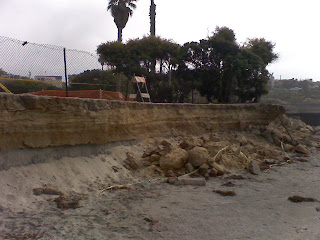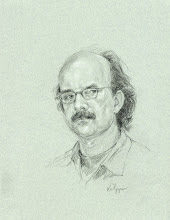Saturday, August 30, 2008
Tuesday, August 26, 2008
The Erosion Continues
Overnight, a foot of blufftop land can collapse onto the beach, and be quickly eroded by a high tide.
Sunday, August 24, 2008
Piazza Basilone, Little Italy, SD
Sea Horse
Here is an initial lay-in sketch for a painting intended to be a name for a home. It is a sea horse but I intend to make it an identity for a beach-area home, which I'll probably suggest being called Sea House. Why? I am compelled when various buildings, especially homes, are given personalities and individual identities. Think of English houses with names like Treetops or Mill House. Websites like YourSigns.com and English House Names tell a bit of the English house name history.
To me, such naming of homes projects a certain history, connection to a neighborhood, ownership and care taking--which in turn contributes to a sense of place, and stewardship of the local community.
If you sense this mission is trivial, please understand that I don't. Strengthening our neighborhoods is what I consider to be one of our highest priorities. Naming a house and instilling pride in a house is nowhere near a complete solution, of course. But it is represents a fundamental accountability and stewardship, and I feel these things accrete when put in place. Plus it is fun for me.
Neighborhood Shrine -- Early Stages
Here is a neighborhood shrine in early stages of painting. You can see the outside two doors, which open to expose a tryptic (more detail will be posted soon). This prototype for this shrine is a sythesis of shrines from the Renaissance which I studied in Italy, and Shinto shrines that I saw in neighborhoods in Japan.
The subject of this shrine is heritage, our ancestry, with prompting from the Mexican celebration Dia de los Muertos (Day of the Dead). This shrine series is part of Pario's exploration of the subject of community identity and belonging.
Thursday, August 21, 2008
Torrey Pines Bluff Collapse
Sunday, August 17, 2008
"ism" Takes Many Forms
Wednesday, August 13, 2008
Trying to Save a Tree
Though the California State Parks have wanted to replace rip rap that protects the San Elijo Campgrounds and bluffs, there has been no permit approval for the replacement of rip rap from the California Coastal Commission. These bluffs and the campgrounds are a significant part of the local visitor industry. A local land manager told me that there has been about 50 feet or more of this bluff that has eroded in the past 25 years. In this area, I would estimate that about five feet of bluff as eroded in the past 12 months. Bluff protection is controversial. Protecting bluffs can reduce sediment from migrating naturally to nearby (downstream) beaches. Similarly, urban development in San Diego County--such as paving with roads, parking lots, or building pads--areas around creeks or making runoff routes otherwise impermeable, reduces soils mirgation toward the beach. We need to have accessible, accurate information about the whole-system implication of our development and presevation decisions. We do not have that now.
Tuesday, August 12, 2008
Non Natives Go Home


Non native plants are becoming the focus of new policy in Encinitas. In a North County Times article, San Elijo Conservancy Executive Director Doug Gibson indicates that the Conservancy has spent close to $2 million in the past five years to remove invasive plants. In California, the annual cost is estimated by the California Invasive Plant Council to be about $100 million.
The draft Encinitas policy lists 86 invasive plants that should be removed from City property and new developments, and 20 toxic plants that should be removed from City property and equestrian trails.
Pampas grass, one of the most problematic invasive plants, clogs this storm water channel along the Coast Highway several times a year, and tractors and trucks can be seen diligently removing the thickets.
We are entering an era wherein a better full cost accounting is being conducted of the implications of our policies, regulations, and lifestyle choices. Doing so brings new information to light, and in most cases somebody has an interest in doing things the 'old way,' and thus there is resistance to changes that may be beneficial overall. Other examples of pending changes include AB 32 and GHG emission reduction targets, and either eliminating, taxing, or otherwise incentivising a reduction in plastic bags being provided at retail stores. Plastic bag litter is expensive for municipalities to remove, causes equipment maintenance problems, and is harmful to wildlife.
So, non natives go home -- we are 'accounting' on you!
Thursday, August 7, 2008
Tuesday, August 5, 2008
Solar Trash Compactor
I find interesting the ways that technology can enhance sustainable performance, and the cost-benefit circumstances of each. Seems that a big part of sustainable performance of this trash system rests on the treatment of trash once picked up from these solar bins. In this instance, the bin has a recycling receptical. In another two installations nearby, there are no recycling recepticals, which raises the question of whether or not the trash is sorted once picked up. If not, and if recyclable content is sent to landfills, there may be some environmental loss to offset the gain from less frequent emptying of these trash bins.
Back in the Day...
Imagine what a rise in sea level from another large volcano or global warming might do, or a commensurate rainfall today in light of the urban stormwater runoff complications added since the 1889 storms.
Unique Foreground Buildings are Becoming Rare


Quality foreground buildings of this character are rarely proposed these days, and it seems like people often find reason to object to them in the project approval process.
The Self Realization Fellowship was first established in Encinitas in 1937, and rebuilt after bluff collapses destroyed original facilities in 1942. This large campus and its iconic design have provided a unique introduction to Encinitas as people arrive in downtown from the south. In addition, the SRF programming has become part of a local spiritual and holistic health community.
In 2008, SRF opened a store with a variety of items, shown in the lower photograph. The store offerings and the building itself add another layer of personality to the spiritual community and the spirit of the town.
A wave every 10 seconds or so
Cliff Erosion
Sunday, August 3, 2008
Children & Seven Generations Commitment

Joseph Chilton Pearce says that if we raise children in a nourishing, loving, and skill building manner, most of society's problems can be cured in two generations of remediation.
Our modern lives make this quite a challenge, with our need to work an extraordinary amount in order to earn a living and, in many households, have to additionally endure long and timely commutes. On top of that, the fragmentation of families to far flung cities eliminates the traditional extended family relationships that can be so powerful in raising children. In only one generation of this fragmentation, we can lose the wonders of the generation-to-generation transfer of parenting skills refined over the ages.
Reconsidering how our cities are planned and built can help bring back the needed resources of time and near-by family back to our lives. Indeed, good urban form can organize our lives productively in numerous ways, which we are only now realizing because of the paralyzing cost and emotional discontent of our having done it ineffectively for some time now. We are soaking in it.THE CONNECTION
In addition to local inefficiencies, a new layer of our problem is now being recognized, though this layer has been building for decades. Global climate change and economic dislocations based upon petroleum market conditions are becoming the tail that wags our dog.
Tails are not supposed to wag dogs.If the current equation of environmental, social, economic, and humanitarian conditions are not immediately and widely recognized as our call for self-preserving behavior, we will have--in a deterministic view--"cooked our goose," and it wasn't necessary at all.
With all of the new and elevated talk about sustainability, the reality is that our systemic equations for our use of water, petroleum, and other natural resources are essentially unchanged. This means that our systemic risk is essentially unchanged.These circumstances were not fated. In fact, the intellectual and physical resources necessary for us to live Utopian lives have been available with abundance. It is the personal, communal, and governance decisions that we have made that has become our tragic downfall.I'm not sure how to explain that to my Godson, when it becomes time to tell him. I do know it is an indefensible condition that my generation presents to him, as his inherited future.
If you do not see a tragedy and call for change in the current circumstance, this blog probably contradicts your worldview.The lives that we live and the places in which we live them are interdependent. Our cities and neighborhoods are robbing us of the wisdom, the wealth, and the daily enjoyment that we once had, that we deserve, and that we should have the presence of mind to fight to restore.
We have more things, more statistical wealth than ever. But in terms of our emotions, our state of mind, our daily happiness, and the reality of our children's future--we are impoverished. We have so much opportunity and manage it irresponsibly.DOWN TO BUSINESS
Pario is committed to urban betterment. We understand, and cannot overestimate, the systemic challenges to changing the way we build and live in our human settlements, our cities and regions. Changes must be fully understood in their complexity and risk to organizations and individuals. Failures in the betterment process create yet more obstacles to desired change.
It is human nature and willfulness that has led us astray, and human nature and willfulness that resists favorable change--often based in disproportionate self interest and preservation.Yet it is the same human nature and willfulness that enables change.
URBAN BETTERMENT
Understanding what is possible, and then understanding obstacles is the first step to change. Pario can determine what should be done, the obstacles to doing it, and then we can create a successful plan for implementing the desired change.
At Pario, because we have been doing this for many years longer than our competitors, and often over a decade longer, we understand how to accomplish the current success that is imperative in order to continue betterment initiatives. In implementing sustainability, we have over the years found that the biggest challenge is not identifying what to do, but it is finding the best way to accomplish sustainable goals. The costs and benefits change constantly for organizations. Newcomers in the mainstream development industry do not have the experience or fundamental commitment to urban betterment. They do it as a trend. At Pario, urban betterment has been the essential mission for over 15 years.
* * * *
Native North American Indians are generally credited with the idea of seven generations thinking, or conducting ourselves today in a manner that does not compromise the lives and circumstances of future generations. This is not our invention, but like many we are compelled by it. At Pario, we have since 1995 applied a seven generations commitment to our urban development work.
* * * *
Not only should we think about our children for their benefit, we should also do it for our own. Children are also consumers, managers, and citizens. Youth do a lot to energize, support, and shape our own future. We need to not only nurture them but also to listen to them.
Introduction
Get both perspectives...you can easily switch back and forth between the two with the links under 'More Pario.' We are glad that you visited and hope that you are compelled to add your opinions and ideas.
Also visit the Pario.com website for background on Pario Research.


















